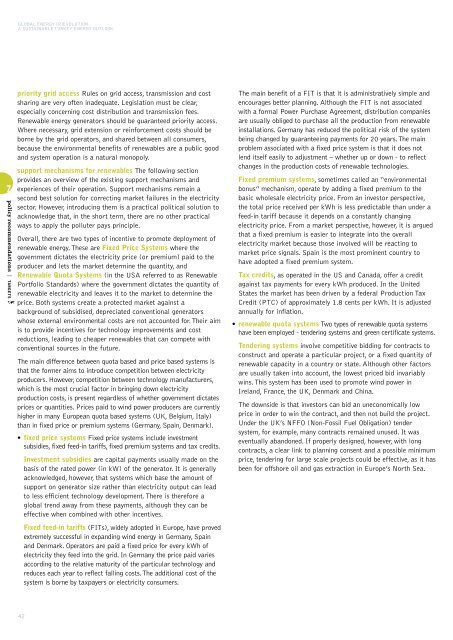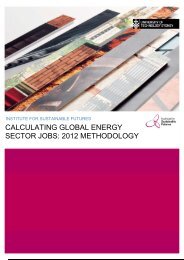download the turkey energy revolution scenario
download the turkey energy revolution scenario
download the turkey energy revolution scenario
You also want an ePaper? Increase the reach of your titles
YUMPU automatically turns print PDFs into web optimized ePapers that Google loves.
GLOBAL ENERGY [R]EVOLUTION<br />
A SUSTAINABLE TURKEY ENERGY OUTLOOK<br />
7<br />
policy recommendations | TARGETS<br />
priority grid access Rules on grid access, transmission and cost<br />
sharing are very often inadequate. Legislation must be clear,<br />
especially concerning cost distribution and transmission fees.<br />
Renewable <strong>energy</strong> generators should be guaranteed priority access.<br />
Where necessary, grid extension or reinforcement costs should be<br />
borne by <strong>the</strong> grid operators, and shared between all consumers,<br />
because <strong>the</strong> environmental benefits of renewables are a public good<br />
and system operation is a natural monopoly.<br />
support mechanisms for renewables The following section<br />
provides an overview of <strong>the</strong> existing support mechanisms and<br />
experiences of <strong>the</strong>ir operation. Support mechanisms remain a<br />
second best solution for correcting market failures in <strong>the</strong> electricity<br />
sector. However, introducing <strong>the</strong>m is a practical political solution to<br />
acknowledge that, in <strong>the</strong> short term, <strong>the</strong>re are no o<strong>the</strong>r practical<br />
ways to apply <strong>the</strong> polluter pays principle.<br />
Overall, <strong>the</strong>re are two types of incentive to promote deployment of<br />
renewable <strong>energy</strong>. These are Fixed Price Systems where <strong>the</strong><br />
government dictates <strong>the</strong> electricity price (or premium) paid to <strong>the</strong><br />
producer and lets <strong>the</strong> market determine <strong>the</strong> quantity, and<br />
Renewable Quota Systems (in <strong>the</strong> USA referred to as Renewable<br />
Portfolio Standards) where <strong>the</strong> government dictates <strong>the</strong> quantity of<br />
renewable electricity and leaves it to <strong>the</strong> market to determine <strong>the</strong><br />
price. Both systems create a protected market against a<br />
background of subsidised, depreciated conventional generators<br />
whose external environmental costs are not accounted for. Their aim<br />
is to provide incentives for technology improvements and cost<br />
reductions, leading to cheaper renewables that can compete with<br />
conventional sources in <strong>the</strong> future.<br />
The main difference between quota based and price based systems is<br />
that <strong>the</strong> former aims to introduce competition between electricity<br />
producers. However, competition between technology manufacturers,<br />
which is <strong>the</strong> most crucial factor in bringing down electricity<br />
production costs, is present regardless of whe<strong>the</strong>r government dictates<br />
prices or quantities. Prices paid to wind power producers are currently<br />
higher in many European quota based systems (UK, Belgium, Italy)<br />
than in fixed price or premium systems (Germany, Spain, Denmark).<br />
• fixed price systems Fixed price systems include investment<br />
subsidies, fixed feed-in tariffs, fixed premium systems and tax credits.<br />
Investment subsidies are capital payments usually made on <strong>the</strong><br />
basis of <strong>the</strong> rated power (in kW) of <strong>the</strong> generator. It is generally<br />
acknowledged, however, that systems which base <strong>the</strong> amount of<br />
support on generator size ra<strong>the</strong>r than electricity output can lead<br />
to less efficient technology development. There is <strong>the</strong>refore a<br />
global trend away from <strong>the</strong>se payments, although <strong>the</strong>y can be<br />
effective when combined with o<strong>the</strong>r incentives.<br />
Fixed feed-in tariffs (FITs), widely adopted in Europe, have proved<br />
extremely successful in expanding wind <strong>energy</strong> in Germany, Spain<br />
and Denmark. Operators are paid a fixed price for every kWh of<br />
electricity <strong>the</strong>y feed into <strong>the</strong> grid. In Germany <strong>the</strong> price paid varies<br />
according to <strong>the</strong> relative maturity of <strong>the</strong> particular technology and<br />
reduces each year to reflect falling costs. The additional cost of <strong>the</strong><br />
system is borne by taxpayers or electricity consumers.<br />
The main benefit of a FIT is that it is administratively simple and<br />
encourages better planning. Although <strong>the</strong> FIT is not associated<br />
with a formal Power Purchase Agreement, distribution companies<br />
are usually obliged to purchase all <strong>the</strong> production from renewable<br />
installations. Germany has reduced <strong>the</strong> political risk of <strong>the</strong> system<br />
being changed by guaranteeing payments for 20 years. The main<br />
problem associated with a fixed price system is that it does not<br />
lend itself easily to adjustment – whe<strong>the</strong>r up or down - to reflect<br />
changes in <strong>the</strong> production costs of renewable technologies.<br />
Fixed premium systems, sometimes called an “environmental<br />
bonus” mechanism, operate by adding a fixed premium to <strong>the</strong><br />
basic wholesale electricity price. From an investor perspective,<br />
<strong>the</strong> total price received per kWh is less predictable than under a<br />
feed-in tariff because it depends on a constantly changing<br />
electricity price. From a market perspective, however, it is argued<br />
that a fixed premium is easier to integrate into <strong>the</strong> overall<br />
electricity market because those involved will be reacting to<br />
market price signals. Spain is <strong>the</strong> most prominent country to<br />
have adopted a fixed premium system.<br />
Tax credits, as operated in <strong>the</strong> US and Canada, offer a credit<br />
against tax payments for every kWh produced. In <strong>the</strong> United<br />
States <strong>the</strong> market has been driven by a federal Production Tax<br />
Credit (PTC) of approximately 1.8 cents per kWh. It is adjusted<br />
annually for inflation.<br />
• renewable quota systems Two types of renewable quota systems<br />
have been employed - tendering systems and green certificate systems.<br />
Tendering systems involve competitive bidding for contracts to<br />
construct and operate a particular project, or a fixed quantity of<br />
renewable capacity in a country or state. Although o<strong>the</strong>r factors<br />
are usually taken into account, <strong>the</strong> lowest priced bid invariably<br />
wins. This system has been used to promote wind power in<br />
Ireland, France, <strong>the</strong> UK, Denmark and China.<br />
The downside is that investors can bid an uneconomically low<br />
price in order to win <strong>the</strong> contract, and <strong>the</strong>n not build <strong>the</strong> project.<br />
Under <strong>the</strong> UK’s NFFO (Non-Fossil Fuel Obligation) tender<br />
system, for example, many contracts remained unused. It was<br />
eventually abandoned. If properly designed, however, with long<br />
contracts, a clear link to planning consent and a possible minimum<br />
price, tendering for large scale projects could be effective, as it has<br />
been for offshore oil and gas extraction in Europe’s North Sea.<br />
42



![Energy [R]evolution - European Commission](https://img.yumpu.com/49109324/1/184x260/energy-revolution-european-commission.jpg?quality=85)


![5905 gp [eu rev]csfr4.qxd - Energy [R]evolution](https://img.yumpu.com/42305023/1/184x260/5905-gp-eu-revcsfr4qxd-energy-revolution.jpg?quality=85)

![5905 gp [eu rev]csfr4.qxd - Energy [R]evolution](https://img.yumpu.com/28729264/1/184x260/5905-gp-eu-revcsfr4qxd-energy-revolution.jpg?quality=85)
